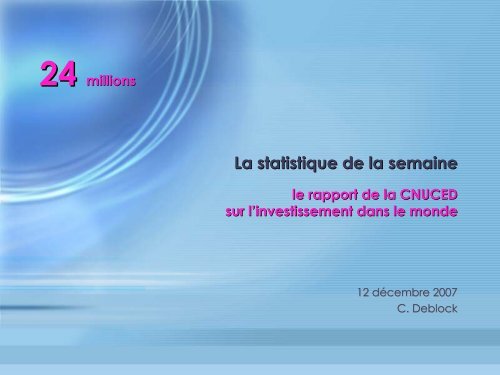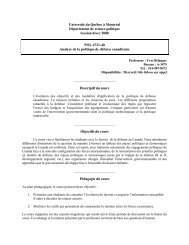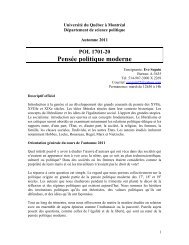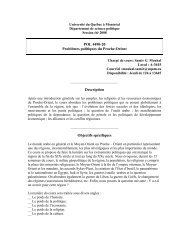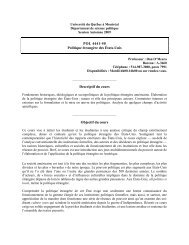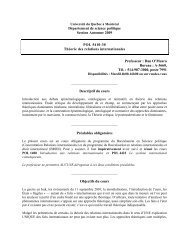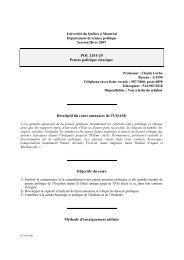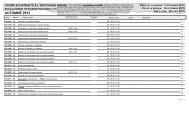11. Le rapport de la CNUCED sur l'investissement dans le monde
11. Le rapport de la CNUCED sur l'investissement dans le monde
11. Le rapport de la CNUCED sur l'investissement dans le monde
- No tags were found...
You also want an ePaper? Increase the reach of your titles
YUMPU automatically turns print PDFs into web optimized ePapers that Google loves.
24 millionsCe serait <strong>le</strong> nombre <strong>de</strong> sa<strong>la</strong>riés à l’emploi <strong>dans</strong> <strong>de</strong>sfilia<strong>le</strong>s étrangères en Chineselon <strong>le</strong>s estimations du Ministère chinois du commerceCentre d’étu<strong>de</strong>s <strong>sur</strong> l’intégration et <strong>la</strong> mondialisation
• Selon <strong>la</strong> <strong>CNUCED</strong>, 73 millions <strong>de</strong> personnes travail<strong>le</strong>nt <strong>dans</strong> <strong>le</strong>sfilia<strong>le</strong>s étrangères <strong>de</strong>s sociétés transnationa<strong>le</strong>s• <strong>Le</strong> tiers <strong>de</strong>s emplois se trouverait en Chine• <strong>Le</strong>s multinationa<strong>le</strong>s américaines emploient quelque 10,5millions <strong>de</strong> sa<strong>la</strong>riés <strong>dans</strong> <strong>le</strong>urs filia<strong>le</strong>s (non bancaires)<strong>dans</strong> <strong>le</strong>mon<strong>de</strong>, dont• 547 mil<strong>le</strong> en Chine et 111 mil<strong>le</strong> à Hong KongCentre d’étu<strong>de</strong>s <strong>sur</strong> l’intégration et <strong>la</strong> mondialisationSource : Survey of Current Business, novembre 2007
La <strong>CNUCED</strong> estime à 78 000 <strong>le</strong> nombre <strong>de</strong> sociétéstransnationa<strong>le</strong>s <strong>dans</strong> <strong>le</strong> mon<strong>de</strong> et à 780 000 <strong>le</strong>nombre <strong>de</strong> <strong>le</strong>urs filia<strong>le</strong>sL’activité <strong>de</strong>s filia<strong>le</strong>s représente :* 10 % du PIB mondial et* <strong>le</strong> tiers <strong>de</strong>s exportations mondia<strong>le</strong>sSauf indication contraire, <strong>le</strong>s données proviennent du WIR 2007Centre d’étu<strong>de</strong>s <strong>sur</strong> l’intégration et <strong>la</strong> mondialisation
Investissements directs et production internationa<strong>le</strong>Indicateurs choisis1982 1990 2000 2005 2006IDEE/PIBW 5,3 8,1 19,8 22,6 24,8XW/PIBW 17,7 19,6 22,1 28,3 29,2PIBFMN/PIBW 5,6 6,8 9,9 9,4 10,1XFMN/XW 32,4 35,2 50,8 33,3 33,3XFMN/VFMN 25,1 24,9 22,8 19,6 18,7XFMN/PIBFMN 101,8 101,5 112,8 100,3 96,8LFMN 21,5 25,1 45,6 63,8 72,6Note : IDEE : stock d'IDE entrants ; PIBW : PIB mondial ; PIBFMN : Production brute <strong>de</strong>s filia<strong>le</strong>s <strong>de</strong> FMN ;XW : exportations mondia<strong>le</strong>s <strong>de</strong> B&S ; XFMN ; exportations <strong>de</strong>s filia<strong>le</strong>s ; VFMN : ventes <strong>de</strong>s filia<strong>le</strong>s ;LFMN : emploi <strong>dans</strong> <strong>le</strong>s filia<strong>le</strong>s, en millions.Source : <strong>CNUCED</strong>Centre d’étu<strong>de</strong>s <strong>sur</strong> l’intégration et <strong>la</strong> mondialisation
Où se trouvent <strong>le</strong>s filia<strong>le</strong>s <strong>de</strong>s 100 plus gran<strong>de</strong>s FMN<strong>de</strong>s pays développés s ?Centre d’étu<strong>de</strong>s <strong>sur</strong> l’intégration et <strong>la</strong> mondialisation
1 306 milliards <strong>de</strong> dol<strong>la</strong>rs• 1306 milliards <strong>de</strong> $, c’est <strong>le</strong> montant <strong>de</strong>s entréesd’investissements directs (IDE) en 2006, dont 857 millions<strong>dans</strong> <strong>le</strong>s pays développés• <strong>Le</strong> stock d’IDE représente <strong>le</strong> quart du PIB mondial• Avec 175 millions <strong>de</strong> $, <strong>le</strong>s États-Unis ont été <strong>la</strong> première<strong>de</strong>stination <strong>de</strong>s IDE en 2006 ; <strong>le</strong>s États-Unis sont éga<strong>le</strong>ment<strong>le</strong>s premiers investisseurs <strong>dans</strong> <strong>le</strong> mon<strong>de</strong> : 217 millions <strong>de</strong> $• Avec 69,6 millions <strong>de</strong> $ d’entrées, <strong>la</strong> Chine a été <strong>la</strong>première <strong>de</strong>stination <strong>de</strong> l’IDE <strong>dans</strong> <strong>le</strong>s pays endéveloppementCentre d’étu<strong>de</strong>s <strong>sur</strong> l’intégration et <strong>la</strong> mondialisation
Entrées d’IDE, milliards <strong>de</strong> $Centre d’étu<strong>de</strong>s <strong>sur</strong> l’intégration et <strong>la</strong> mondialisation
Quatre facteurs stimu<strong>le</strong>nt l’IDE• La croissance <strong>de</strong> l’économie mondia<strong>le</strong>, entre 2004 et 2006, n’ajamais été aussi vigoureuse <strong>de</strong>puis <strong>le</strong>s années 1970 :• selon <strong>le</strong> FMI, <strong>le</strong> PIB (réel) a progressé <strong>de</strong> 5,2 % en moyenne par annéeet <strong>le</strong> PIB par habitant en âge <strong>de</strong> travail<strong>le</strong>r, <strong>de</strong> 31/4%.• Selon l’OMC, <strong>le</strong>s exportations mondia<strong>le</strong>s ont progressé <strong>de</strong> 8,1 %• <strong>Le</strong>s profits réinvestis:• <strong>Le</strong>s profits n’ont jamais été aussi é<strong>le</strong>vés <strong>de</strong>puis <strong>de</strong>ux décennies. En 2006,<strong>le</strong>s profits réinvestis ont représenté 30 % <strong>de</strong>s IDE mondiaux et près <strong>de</strong> <strong>la</strong>moitié <strong>de</strong>s IDE <strong>dans</strong> <strong>le</strong>s pays en développement• <strong>Le</strong>s fusions-acquisitions :• Il y en a eu 6 974, pour une va<strong>le</strong>ur tota<strong>le</strong> <strong>de</strong> 880 milliards <strong>de</strong> $• El<strong>le</strong>s sont <strong>sur</strong>tout financées par <strong>le</strong>s trésoreries et <strong>le</strong>s emprunts• <strong>Le</strong>s fonds <strong>de</strong> capital-p<strong>la</strong>cement, p<strong>la</strong>cement, privés et souverains• <strong>Le</strong>s fonds privés ont été responsab<strong>le</strong>s <strong>de</strong> près <strong>de</strong> <strong>la</strong> moitié <strong>de</strong>s fusionsacquisitions,soit 432 milliards <strong>de</strong> $• <strong>Le</strong>s fonds souverains ont été responsab<strong>le</strong>s <strong>de</strong> 18 % <strong>de</strong>s fusionsacquisitions,soit 158 milliards <strong>de</strong> $Centre d’étu<strong>de</strong>s <strong>sur</strong> l’intégration et <strong>la</strong> mondialisation1/4 %.
Profits réinvestisen va<strong>le</strong>ur et en % <strong>de</strong>s flux d’IDE, 1990-2006Centre d’étu<strong>de</strong>s <strong>sur</strong> l’intégration et <strong>la</strong> mondialisation
<strong>Le</strong>s fusions-acquisitionsen va<strong>le</strong>ur et en taux <strong>de</strong> variation, 1988-2006Centre d’étu<strong>de</strong>s <strong>sur</strong> l’intégration et <strong>la</strong> mondialisation
<strong>Le</strong>s activités transfrontalièrescontinuent d’augmenter• En 2005, selon <strong>le</strong>s données du Bureau of EconomicAnalysis,<strong>le</strong>s filia<strong>le</strong>s étrangères <strong>de</strong>s sociétés transnationa<strong>le</strong>saméricaines à contrô<strong>le</strong> majoritaire (MOFAs),employaient 28 % <strong>de</strong>s sa<strong>la</strong>riésont réalisé en 29 % <strong>de</strong> <strong>la</strong> va<strong>le</strong>ur ajoutéeet ont fait 28 % <strong>de</strong>s investissements <strong>de</strong>s groupesCentre d’étu<strong>de</strong>s <strong>sur</strong> l’intégration et <strong>la</strong> mondialisation
Indice <strong>de</strong> transnationalité du pays hôteCentre d’étu<strong>de</strong>s <strong>sur</strong> l’intégration et <strong>la</strong> mondialisation
Définitions• IDE :« L’IDE est une activité par <strong>la</strong>quel<strong>le</strong> un investisseur résidant <strong>dans</strong> un pays obtient un intérêt durab<strong>le</strong> etune influence significative <strong>dans</strong> <strong>la</strong> gestion d’une entité résidant <strong>dans</strong> un autre pays. Cette opérationpeut consister à créer une entreprise entièrement nouvel<strong>le</strong> (investissement <strong>de</strong> création) ou, plusgénéra<strong>le</strong>ment, à modifier <strong>le</strong> statut <strong>de</strong> propriété <strong>de</strong>s entreprises existantes (par <strong>le</strong> biais <strong>de</strong> fusions etd’acquisitions). Sont éga<strong>le</strong>ment définis comme <strong>de</strong>s investissements directs étrangers d’autres types <strong>de</strong>transactions financières entre <strong>de</strong>s entreprises apparentées, notamment <strong>le</strong> réinvestissement <strong>de</strong>sbénéfices <strong>de</strong> l’entreprise ayant obtenu l’IDE, ou d’autres transferts en capital ».• Indice <strong>de</strong> transnationalité :Moyenne <strong>de</strong> : (1) flux d’IDE entrant/FBCF (2002/04) ; (2) Stock d’IDE entrant/PIB (2004) ; (3) Va<strong>le</strong>ur ajoutée <strong>de</strong>sfilia<strong>le</strong>s/PIB (2004) ; (4) Emploi <strong>dans</strong> <strong>le</strong>s filia<strong>le</strong>s/emploi total (2004).Centre d’étu<strong>de</strong>s <strong>sur</strong> l’intégration et <strong>la</strong> mondialisation


